There are a host of different tools for garden digging - depending on your approach, technique and personal capacity.
A prime activity for any gardener is that of digging the soil in order to cultivate, loosen and aerate or to help remove weeds.
There are a host of different tools for digging depending on your approach, technique and personal capacity.
Generally garden spades carry more soil on their blades which is good for turning the topsoil over while garden forks are preferred for loosening the soil, requiring less effort.
Digging Spade:
The most common type of spade is the Digging Spade which has a broad blade and sharpened, flat edge to cut through averagely friable soil.
If you are digging trench style e.g. working along in lines, digging a trench then immediately filling it in, then this format of spade is perfect. Though due to the broad dimensions of the blade it will carry a fair weight of soil and therefore not be suitable for those with less strength. The Digging spade is not a tool for fine, detailed work – this is a workhorse tool for big effect to relatively large areas.
Handles are generally made of Ash, being a traditionally strong yet slightly flexible wood. Modern composite plastics are sometimes used for handles which have similar attributes to wood, especially being light weight and contribute to keeping costs lower.

Grips tend to be ‘D’ shaped for maximum comfort and blades should have a flat foot ledge at the top to allow foot pressure without cutting into shoes.
Stainless steel is a must for any spade blade – a good wipe down after use however is always recommended along with a wipe over with an oily rag to set it up well for storage.
Border Spade:
These are slightly smaller in both length and blade width, being designed for lighter workloads and to dig more precisely.
Overall design and features are the same as for Digging Spades with the exception of the blade width which would be around 2/3rds of the size.
These tools are ideal for female gardeners and those who like to tackle their digging work with less overall effort while taking care to dig around roots of existing plants without damage.
 Border Spade - narrower blade
Border Spade - narrower bladeN.B. this tool is sometimes called a ‘Cottage Spade’.
Perennial Spade:
This is an even smaller spade than the Border Spade and has an arrow-shaped blade with only the slightest of curve to it.
It is both useful for small scale accurate digging in amongst existing plants but is also especially good for splitting or dividing perennial plants, which in many cases needs to be performed every few years.
The sharp leading edge helps to cleanly cut through clump roots, rhizomes or clusters of corms and bulbs with minimal tearing or damage. The pointed shape of the blade is also very useful for more accurate work than can be achieved with a regular square ended blade.
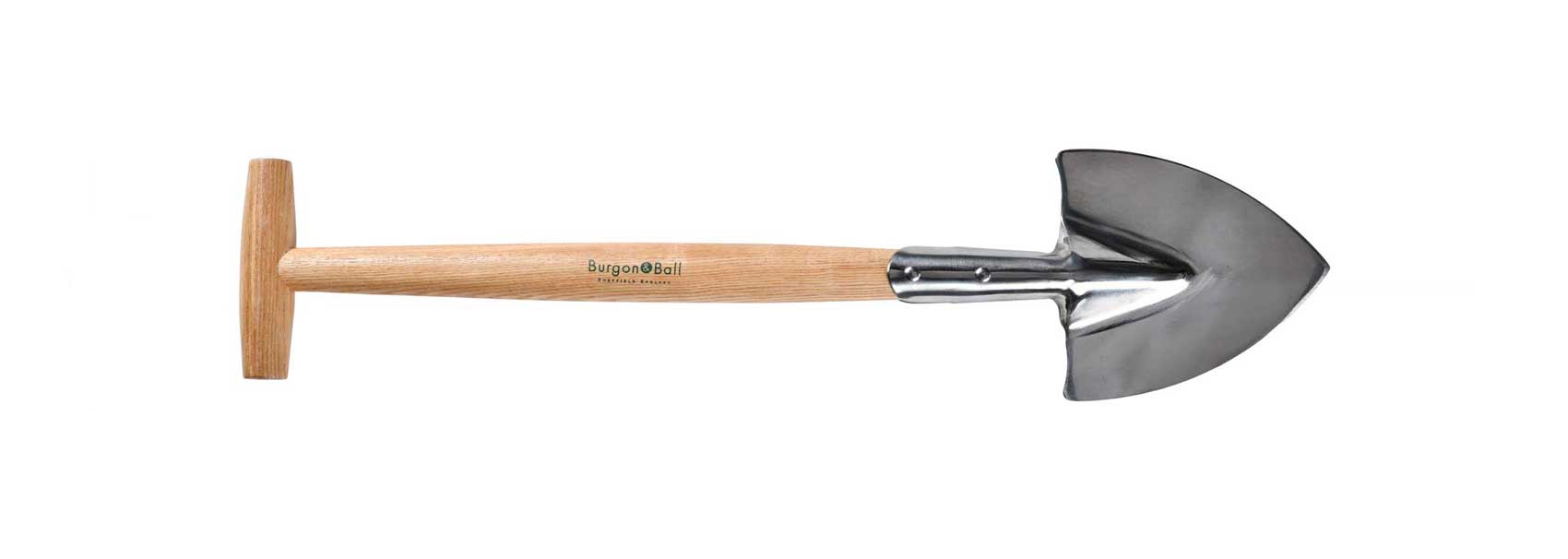 Perennial Spade
Perennial SpadeAgain Ash is the material of choice for lightweight and strong handles, which are noticeably shorter than standard spades. Though the hand grips tend to be ‘Tee’ shaped to make root splitting and dividing easier to control.
GroundBreaker Spade:
These are spades with a pointed leading edge to the blade that will cut more easily into hard packed or heavy clay soils than a flat edged blade.
Like border spades, they tend to have slightly narrower blades as their usage is not intended for turning over large amounts of soil in one go, but as their name suggests it is to break through tough, hard packed or rocky soils.
Materials used are the same as other quality spades e.g. Ash handles with ‘D’ grips and stainless steel blades with flattened footledge to allow full downward pressure from the foot.
They usually come in two sizes, one smaller for female users and larger for male or stronger users.
 Groundbreaker Spade
Groundbreaker SpadeThey are excellent for their designed purpose but can be used as a general purpose garden spade if you only want to purchase one spade.
Transplanter Spade:
Transplanter spades are a specialty design that make the digging up and moving of plants as easy as can be.
They have the dimensions of a regular digging spade and share the same materials of stainless steel and ash wooden handles - but the blades are more inwardly curved and the cutting edge is gently curved as well.
The result is a specialty spade that really helps to cut a smooth, circular cut-out around the plant and is well balanced to remove it as gently as possible, while, most importantly keeping the root-ball in one piece.
It then provides a safe cradle shape to move the plant in question to its new location and insert into its new hole or home with accuracy.
 Transplanting Spade
Transplanting SpadeDue to their similarity of size and weight to digging and border spades, Transplanter spades can double up for general purpose garden digging if you only want to purchase one spade hand tool.
Pickaxe or Mattock:
These are not purely designed for the complete action of digging, but sometimes useful to break the top level of soil when it is so hard-packed or stony that even a Groundbreaker Spade cannot make progress on it its own.
They consist of a single steel head with two cutting prongs, either one horizontal, the other vertical or one pointed and the other either flat or vertically orientated.
Handles tend to be shorter than most other larger hand tools and made of wood or composite plastic, though they can also be fibreglass.
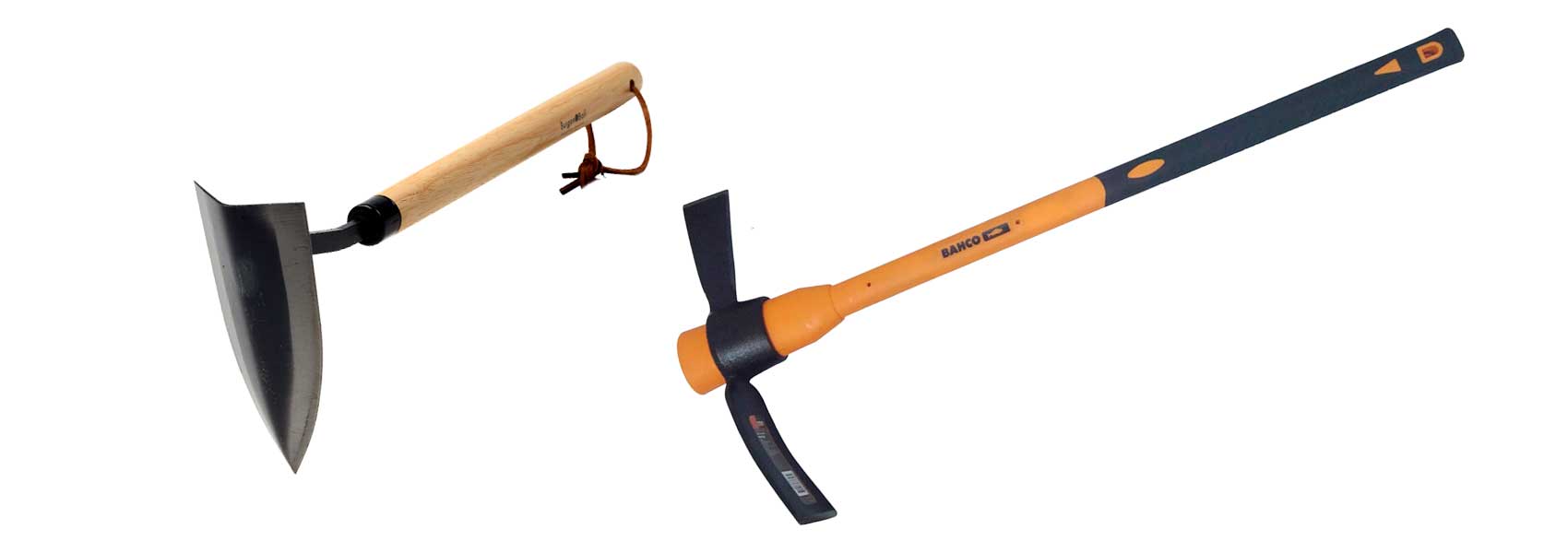 L. Mighty Pick - Burgon & Ball R. Traditional Mattock - Bahco
L. Mighty Pick - Burgon & Ball R. Traditional Mattock - BahcoThe handles take a lot of stress and pressure so tend to be thick yet narrow enough to wrap your hands around.
Replacing handles is very easy and not expensive.
Shovels:
Shovels are not designed to break the soil but to move larger quantities of pre-loosened soil.
The blades are usually thin, pressed steel, often galvanised rather than stainless steel and therefore much cheaper. They have raised edges and a curved overall shape to hold quantities of broken soil on the blade during re-location.
These are lighter weight tools as their only purpose is for re-location and not breaking or loosening soil.
They can of course also be used to move quantities of any loose materials like gravel, compost, sand or animal feedstuff.
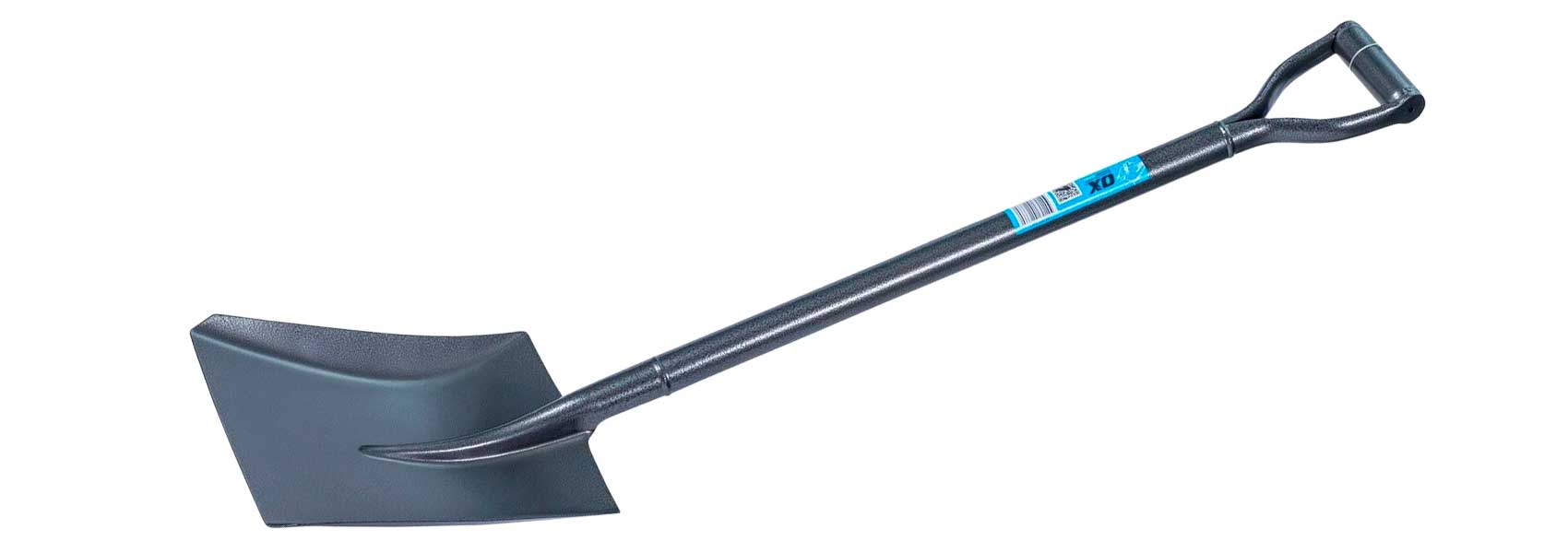 Shovel
ShovelHandles can be either tubular galvanised steel, wood or composite plastics.
PostHole Shovels:
Posthole Shovels have straight sided, longer blade heads that are usually made of galvanised pressed steel for lightness and reasonable strength.
The blade is generally slightly curved to allow both cutting and shovelling of the loosened soil.
The handles tend to be much longer than other spades or shovels and do not have a ‘D’ shaped hand grip, just one long and thin straight handle.
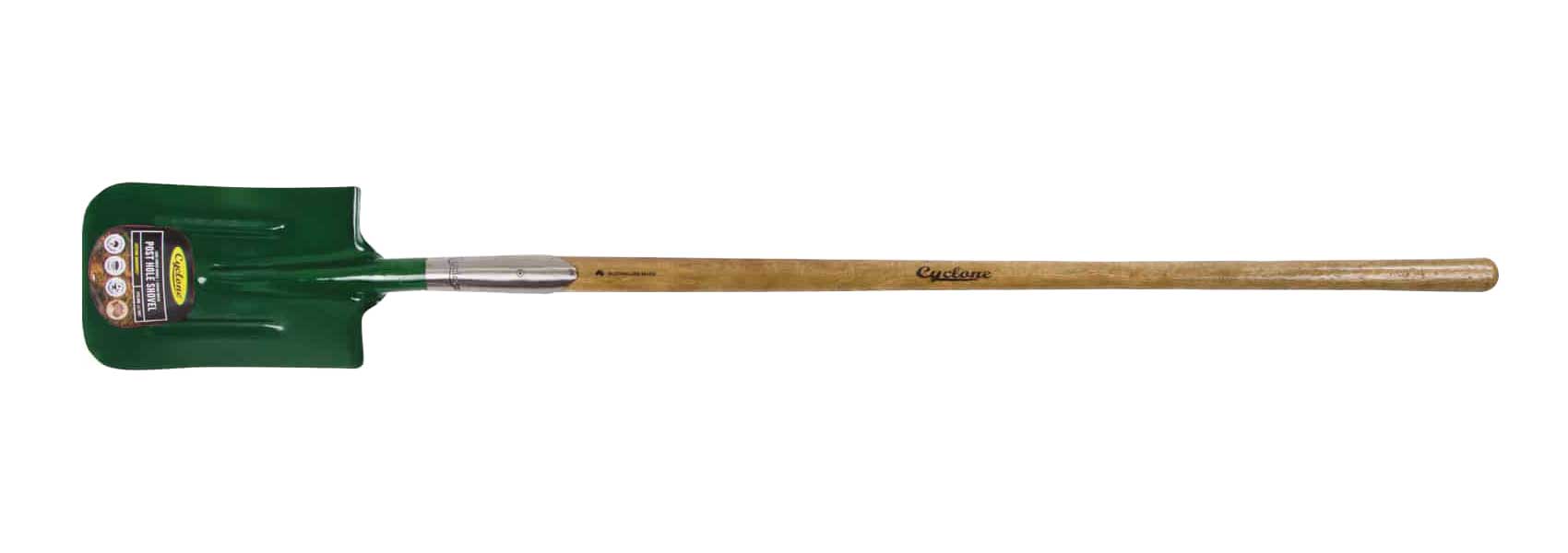 Post-Hole Shovel
Post-Hole ShovelBlades must have a good foot ledge as post hole digging requires plenty of foot pressure.
Garden Forks:
Digging Forks are the ubiquitous design and feature four stainless steel tines and a flattened foot ledge, though they tend to be narrower than that of spades as less downward pressure is required with a fork.
Handles tend to be Ash, fibreglass or composite plastics, while some of the latter may be curvy to create the ultimate ergonomics (which cannot be achieved with traditional wood or fibreglass – hence the often very high price).
Border Forks are intended to just break up the top soil, especially where it has become compacted therefore restricting water and air ingress into the soil.
They are also useful when weeding in amongst established plants to break the soil and make hand collection of weeds easier.
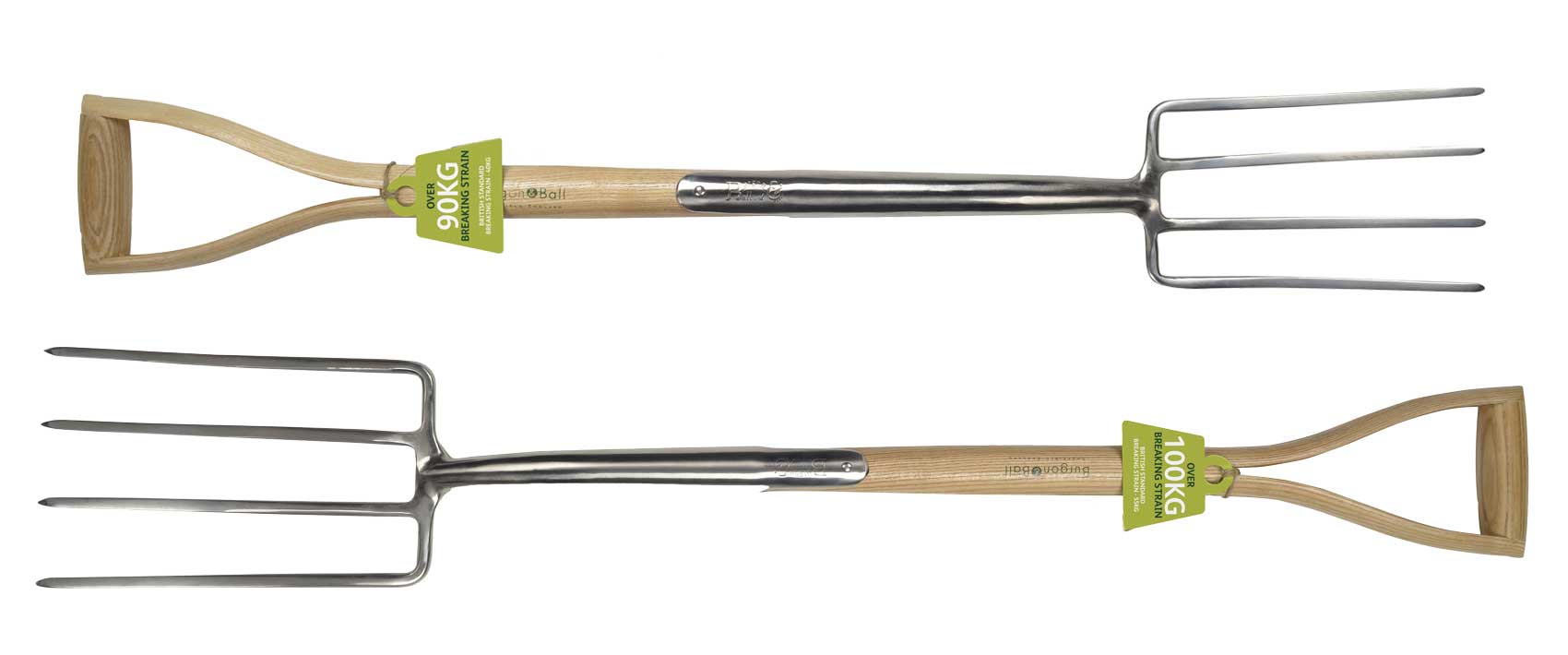 Top - Border Fork Bottom - Digging fork
Top - Border Fork Bottom - Digging forkBorder Forks come in a variety of sizes, being specifically aimed at users of different physical sizes and strength, while smaller fork heads are particularly useful for getting in amongst existing plants while minimising root disturbance.
Half Moon Edgers;
The Half-Moon Edger is a very specialised tool specifically designed to slice turf at the edge of a lawn to provide a crisp and clean edge.
Half Moon Edgers are a very ecological alternative to the polluting and noisy strimmers, though they do require a little more effort and skill in use.
They consist of a stainless steel, 'Half-Moon', sharpened edge, flat blade, a flattened foot-ledge for downward foot pressure, a sturdy wooden handle, usually made from Ash and a large ‘Tee’ shaped handle for extra control.
 Half-Moon Edger for Burgon & Ball
Half-Moon Edger for Burgon & BallThese are very traditional tools, generally easier to find in Europe, though the GardensOnline shop does feature edgers from Burgon & Ball of the UK and Wolf Garten of Germany.
Bulb Planters:
These are very specialised tools specifically designed to dig small round holes in lawns or borders that are just big enough to plant bulbs – usually spring bulbs like tulips and daffodils.
They feature a ninety degree foot ledge for good downward pressure and a ‘cut-away’ steel tube head to make soil plug removal easy.
As with post hole shovels, the handles are long, though bulb planters often feature ‘Tee’ shaped hand grips.
 Bulb Planter
Bulb PlanterShort or mid handled versions are also popular, though the full length format reuqires a lot less effort to use.
Summary:
Who would have thought there could be so many different ways to break the soil? Well there are even more not mentioned so far but they tend to be for very specialised or niche uses.
Overall we hope you are now armed to make the most informed purchase decision for your next digging hand tool.
As with all tools, generally the more you pay the better value you receive. Yes, that’s true, don’t mix up cheapness with value. A Garden Spade costing over $100 will most likely last you a lifetime and perhaps even longer while the cheap Chinese knock-offs will most likely bring you pleasure for only a few months or years at most.
And then there’s the pure pleasure of using a quality, well designed and well made tool – for discerning gardeners there’s nothing better than the feel of a well balanced hand tool, made to last from stainless steel and quality wood.
It's all part of the pleasure of gardening.
Most tools mentioned here are available from the GardensOnline shop, for convenient and easy garden shopping 24/7/365.